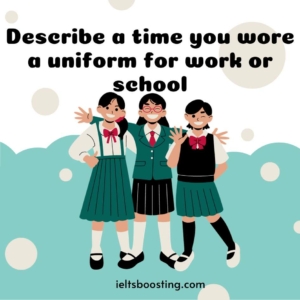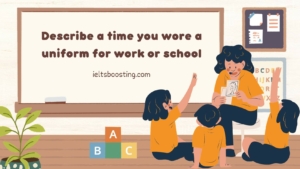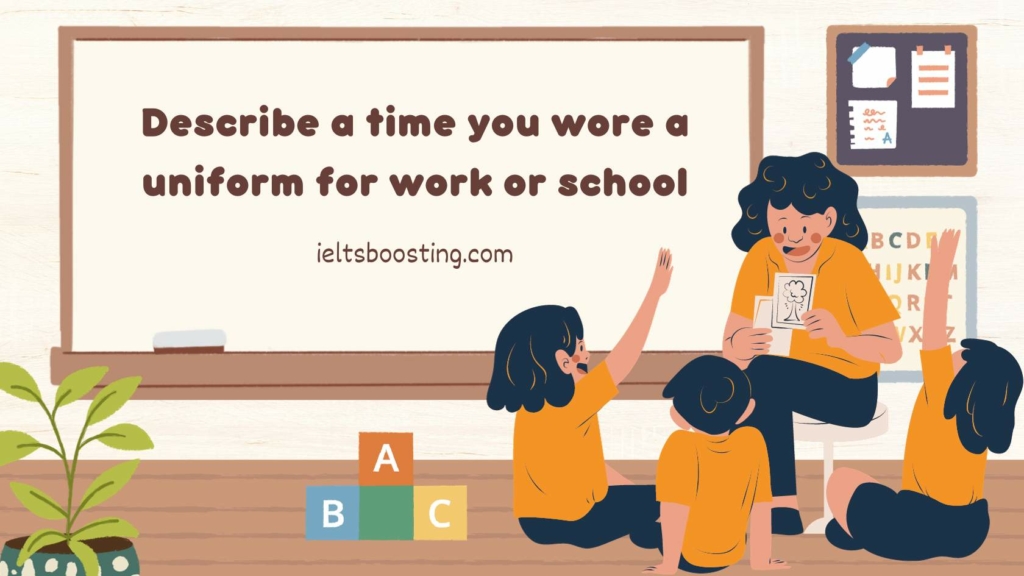Describe a time you wore a uniform for work or school
You should say:
Where you wear the uniform
How long you need to wear it
Who bought it for you
And explain how you feel about it

Describe a time you wore a uniform for work or school
Sample answer
I vividly remember wearing a uniform during my high school years. The uniform was a standard requirement at my school, and it was something we had to wear every single day, without exception. It was my father who bought the uniform for me from the school’s designated uniform shop. This was quite convenient as it ensured that the uniform matched the school’s exact specifications in terms of color and design.
The uniform consisted of a white shirt and dark trousers, paired with a school tie and a blazer with the school emblem. I must say, it was quite comfortable to wear. The fabric was soft and breathable, which was particularly important as we had to wear it throughout the day, often in varying weather conditions.
One aspect I really appreciated about wearing a uniform was the sense of equality it brought among the students. Since everyone was dressed identically, there were no apparent distinctions based on clothing choices. This uniformity seemed to create a more focused environment, where the emphasis was more on learning and personal development rather than on what everyone was wearing.
Overall, my feelings towards wearing a uniform are quite positive. Not only did it save time in the mornings when deciding what to wear, but it also fostered a sense of unity and belonging among us students. It was a symbol of our school’s identity, and wearing it made me feel like an integral part of the school community.
Useful vocab
- Vividly – in a way that produces strong, clear images in the mind.
- Standard requirement – a usual or necessary condition or rule.
- Designated – officially assigned or specified.
- Specifications – detailed descriptions or assessments.
- Fabric – the material from which clothing is made.
- Breathable – allowing air to pass through, ensuring comfort.
- Equality – the state of being equal, especially in status, rights, or opportunities.
- Identically – in exactly the same way.
- Distinctions – differences or contrasts.
- Uniformity – the quality or state of being uniform; overall sameness.
- Focused environment – a setting where attention is directed to specific tasks or subjects.
- Personal development – the process of improving oneself.
- Unity – the state of being united or joined as a whole.
- Symbol – a mark or sign that represents something else.
- Integral – essential or fundamental.
- Community – a group of people living in the same place or having particular characteristics in common.
- Emphasis – special importance, value, or prominence given to something.
- Convenient – fitting in well with a person’s needs, activities, and plans.
Forecast speaking from 1-4 2024

Describe a time you wore a uniform for work or school
Part 3 – Describe a time you wore a uniform for work or school
Why should students wear uniforms?
Students should wear uniforms primarily for creating a sense of equality and belonging among them. Uniforms eliminate any potential socioeconomic divisions that might arise from varying clothing styles and brands, ensuring that all students are viewed on equal terms. Additionally, wearing a uniform instills discipline and a sense of pride in one’s school, fostering a positive and respectful learning environment. Furthermore, uniforms simplify morning routines, as students don’t have to decide what to wear each day, allowing them to focus more on their studies.
Useful Vocabulary:
- Equality – the state of being equal, especially in status, rights, or opportunities.
- Socioeconomic divisions – differences among people based on social and economic factors.
- Instill discipline – to gradually establish an idea or habit in someone’s mind or behavior.
- Sense of pride – a feeling of deep pleasure or satisfaction derived from achievements.
- Learning environment – the physical or psychological conditions in which one learns.
- Simplify – to make something less complex or easier to do.
- Morning routines – the usual sequence of actions or behaviors one follows after waking up.
- Focus – the center of interest or activity.
- Studies – academic work or research.
- Belonging – an affinity for a place or situation.
Simpler version
Actually, I think school uniforms are a pretty good idea. They kind of level the playing field, you know? There’s no competition over who’s got the trendiest clothes. Plus, it’s a real time-saver in the morning – no drama about what to wear. It also brings in a bit of discipline and school pride, which is cool. Everyone’s in the same boat, focused more on schoolwork rather than outfits. Makes things simpler, right?
Why should people at work wear uniforms?
People at work should wear uniforms for several key reasons. First off, uniforms create a professional and cohesive image for the company, which can boost public perception. They also help in easily identifying employees, particularly in service industries, enhancing security and customer service. Moreover, for the employees, uniforms eliminate the daily hassle of choosing work attire, saving time and reducing wardrobe expenses. Lastly, in certain jobs, uniforms serve as essential safety gear, protecting workers from potential hazards.
Useful Vocabulary:
- Professional image – the appearance or impression given to others in a work setting.
- Cohesive – forming a united whole.
- Public perception – the way the general public views or regards something.
- Identifying employees – the process of recognizing or distinguishing workers.
- Service industries – businesses that provide services rather than goods.
- Enhancing security – improving safety measures or protocols.
- Customer service – assistance and advice provided to customers.
- Eliminate – completely remove or get rid of.
- Hassle – inconvenience or difficulty.
- Wardrobe expenses – costs associated with buying clothes.
- Safety gear – equipment worn to protect against harm or injury.
- Potential hazards – possible sources of danger.
Simpler version
You know, there are some solid reasons for wearing uniforms at work. For starters, they give a company a really professional look, which can make a big difference in how people see the business. Plus, it’s way easier to spot who works there, especially in places like stores or restaurants. It’s a big help for customers. And for the staff, it’s kind of a relief not having to pick out work clothes every day. Saves time and money. Oh, and in some jobs, like construction, the uniforms are actually safety gear, which is super important for keeping everyone safe.

Describe a time you wore a uniform for work or school
What are the advantages and disadvantages of wearing a uniform?
Wearing a uniform has its ups and downs. On the plus side, uniforms bring about a sense of unity and equality; everyone looks the same, so there’s less pressure about what to wear. They also save time in the morning and can make you feel more professional. But on the flip side, uniforms can stifle personal expression, as everyone has to dress the same way. And sometimes, they’re not the comfiest or the most stylish choice.
Useful Vocabulary:
- Unity – the state of being united or joined as a whole.
- Equality – the state of being equal, especially in status, rights, or opportunities.
- Pressure – the use of persuasion or intimidation to make someone do something.
- Professional – relating to or connected with a profession.
- Stifle – make (someone) unable to breathe properly; suffocate.
- Personal expression – the act of expressing one’s personality, feelings, or ideas, especially through appearance or art.
- Comfy – comfortable.
- Stylish – fashionable and attractive.
Simpler version
So, about uniforms, right? They’ve got their good points – like making everyone feel part of a team, and honestly, they save you from deciding what to wear every day. Plus, you kind of feel more official in a uniform. But the downside? They don’t really let you show your style, and let’s be real, sometimes they’re just not that comfortable or cool-looking.


